The Sandy Bridge Preview
by Anand Lal Shimpi on August 27, 2010 2:38 PM ESTAdobe Photoshop CS4 Performance
To measure performance under Photoshop CS4 we turn to the Retouch Artists’ Speed Test. The test does basic photo editing; there are a couple of color space conversions, many layer creations, color curve adjustment, image and canvas size adjustment, unsharp mask, and finally a gaussian blur performed on the entire image.
The whole process is timed and thanks to the use of Intel's X25-M SSD as our test bed hard drive, performance is far more predictable than back when we used to test on mechanical disks.
Time is reported in seconds and the lower numbers mean better performance. The test is multithreaded and can hit all four cores in a quad-core machine.
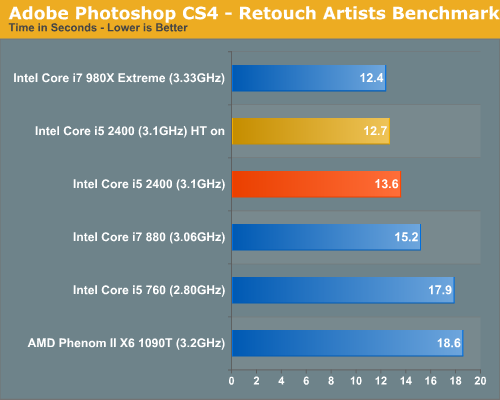
Right off the bat Sandy Bridge is killer. In our Photoshop test it’s faster than its closest quad-core price competitor, faster than its identically clocked Lynnfield, faster than AMD’s fastest and loses out only to Intel’s $999 Core i7 980X. That being said, it only takes about 9% longer to complete our benchmark than the 980X.
DivX 6.5.3 with Xmpeg 5.0.3
Our DivX test is the same DivX / XMpeg 5.03 test we've run for the past few years now, the 1080p source file is encoded using the unconstrained DivX profile, quality/performance is set balanced at 5 and enhanced multithreading is enabled:
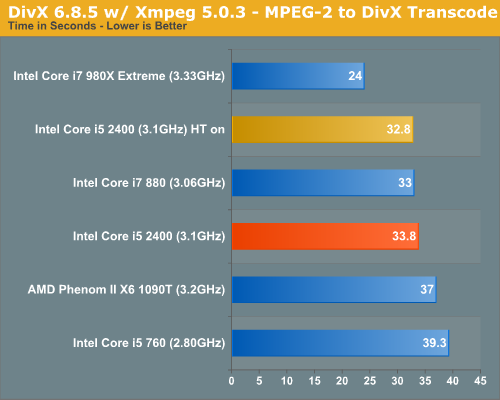
While not the most stressful encoding test, it’s still a valid measure of performance and once again, Sandy Bridge is faster than all. In this case we’re faster than the Core i5 760 (~16%) and just behind the Core i7 880. Clock for clock there's not a huge improvement in performance here (HT doesn't seem to do much), it's just a better value than the 760 assuming prices remain the same.
x264 HD Video Encoding Performance
Graysky's x264 HD test uses the publicly available x264 encoder to transcode a 4Mbps 720p MPEG-2 source. The focus here is on quality rather than speed, thus the benchmark uses a 2-pass encode and reports the average frame rate in each pass.
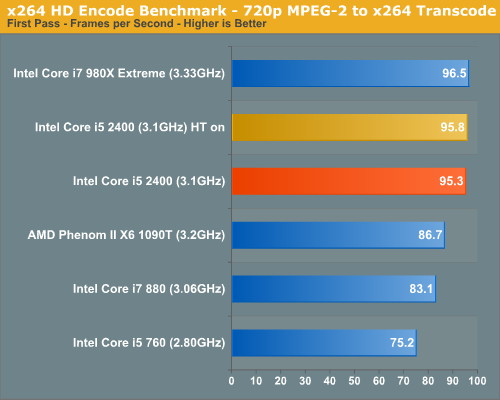
Lightly threaded performance is much improved - the 2400 is 14.6% faster than the Core i7 880.
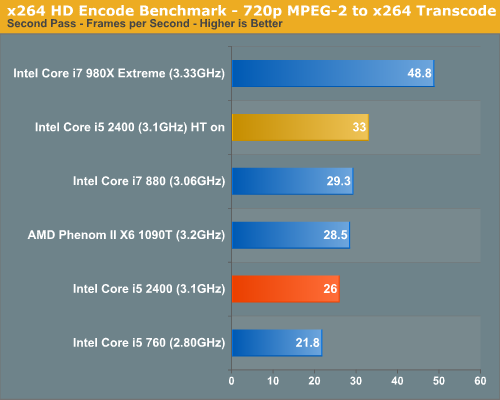
The actual encoding pass favors more threads, so we see a big improvement over the 760 (19%) but it falls short of the Core i7 880. Turn HT on and we get a 12.6% improvement over an identically clocked/configured Lynnfield.
Note that CPU based video encoding performance may not matter if Intel implemented a good video transcode engine in Sandy Bridge.
Windows Media Encoder 9 x64 Advanced Profile
In order to be codec agnostic we've got a Windows Media Encoder benchmark looking at the same sort of thing we've been doing in the DivX and x264 tests, but using WME instead.
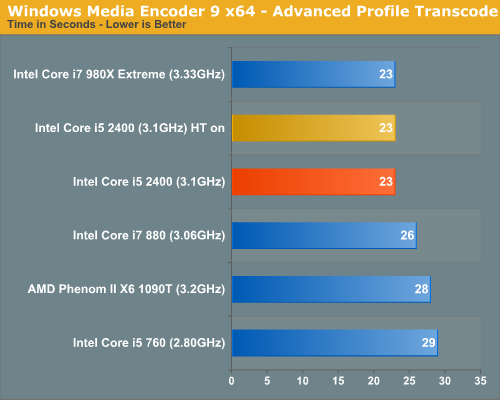
Performance in WME rarely scales anymore. Our benchmark doesn’t scale well beyond 4 cores and the only hope for performance are increases in clock speed or IPC. Sandy Bridge delivers the latter.
A 20% increase in performance vs. the similarly clocked 880 in a test that doesn’t scale with anything but IPC tells you a lot. Compared to the Core i5 760, Sandy Bridge is 26% faster.










200 Comments
View All Comments
Anand Lal Shimpi - Friday, August 27, 2010 - link
We'll have to wait a little bit to find out... :)hnzw rui - Friday, August 27, 2010 - link
If it doubles Clarkdale's GPU performance, then it probably will (at least on lower resolutions). I'm getting pretty decent framerates from Clarkdale on 1360x768 Low and I've been able to play on 1360x768 Medium with a Radeon HD 4550. I think Sandy Bridge is probably closer to the latter than the former in performance.SteelCity1981 - Friday, August 27, 2010 - link
Any word when Intel will launch a mobile version of this new platform?Anand Lal Shimpi - Friday, August 27, 2010 - link
Q1 2011 :)BSMonitor - Friday, August 27, 2010 - link
So glad I waited on a 13" macbook pro! Sandy Bridge will probably be the next revision for Macbook's ehh?cheinonen - Friday, August 27, 2010 - link
Exactly my thoughts, that the GPU performance looks to be good enough that Apple could use it for the 13" MBP refresh next year. I'll be glad that I decided to wait, that's fur sure.synergist - Friday, August 27, 2010 - link
I was doing some research and if they would have to use the full integrated graphics core, with the 12 cores, to top the performance of the 320M in the current macbook pro 13 I doubt apple would take a step backwards in gfx performance, and use the 6 core integrated gfx.and the performance would still be pretty close, that the 320M would lose to the inter grated gfx (12 cores) by about 10-13%
and llano is still an option, but I have a feeling it will be a dead heat with this.
starfalcon - Friday, August 27, 2010 - link
Apple has to know a lot of the people buying the laptops are far from high end gamers.The amount of people with 320Ms who don't need them is probably a lot.
We'll see how all the different parts of Sandy Bridge work out.
Don't the Core iX processors not work with Nvidia Integrated graphics at all?
JarredWalton - Friday, August 27, 2010 - link
Correct on NVIDIA IGPs not working with Core 2010 (and presumably beyond). The need the QPI interface and Intel isn't licensing that to them.As for Apple, one thing to note is that they've started shipping all laptops with GPUs that support OpenCL it seems, so if Sandy Bridge doesn't have that they may do the same Optimus-style setup as current MBP. Not sure what they'd do with the base MacBook in that case, but Apple seems like they're gearing up to start leveraging OpenCL at some point in the near future. Pure speculation, though, so maybe SB's IGP will be enough, even if it's a step down from G320M.
DanNeely - Friday, August 27, 2010 - link
Aside from on the high end (LGA 1366/2011) the bus nVidia needs is DMI, not QPI. If I was nVidia I'd insist on getting rights to both because QPI is more futureproof. Specifically having more than a few high speed SATA6GB/USB3/etc devices will be able to saturate DMI since it's only the equivalent of a PCIe 4x slot (1.0 speed for 1156, 2.0 for 1155/2011) while QPI is a much higher capacity bus similar to AMD's HyperTransport.While intel seems determined to milk as much out of the (presumably) cheaper to implement DMI bus as it can; sooner or later they're going to either need to mainstream QPI or have the CPU die eat the SATA/USB3 controllers. I find the latter unlikely because it would require cramming even more data lines into the already overcrowded CPU socket area.